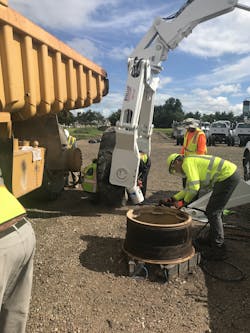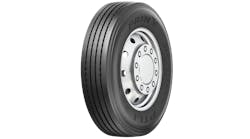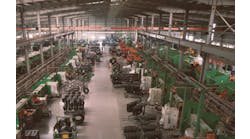The Top 5 Safety Hazards of OTR Tire Service – and How to Avoid Them
Working on OTR tires is certainly outside the normal realm of tire and wheel service. The size and weight of the tires, rim components, bead breakers, and other tools and equipment add a physical element to every job that cannot be understated.
At the same time, the size and weight of the vehicles and machines involved create a higher level of complexity — and a higher level of risk — when compared to other forms of tire and wheel service. Work sites can literally be anywhere, night calls are common, and weather can either work with OTR tire service techs or against them.
Because of these factors, OTR tire service is a tough job that few people can do well on a consistent basis. That’s why safety is extra-important. Taking shortcuts when servicing OTR tires can be a recipe for disaster. One mistake can be deadly when you are working on heavy tires with high air pressures on large machines.
Training is the foundation for workplace safety. It creates good habits while discouraging practices that may be effective but come at the expense of safety for the technician. Training also is the best way for technicians to understand common hazards when working in the field, so they make better decisions.
Experience plays a major role in OTR tire service. When that hands-on experience is combined with the proper training and equipment, technicians are less likely to take unnecessary chances because they can determine the safest way to handle every tire they service.
I recently reached out to people I know in the OTR tire service industry and asked them to list their top five OTR tire service safety hazards. Not surprisingly, the same five kept showing up and in most cases, they were in the same order. I know for a fact that violations of the top three have contributed to fatalities, and injuries related to the other two can be preventable.
5) Personal protective equipment (PPE). Protective eye wear is a must. And since practically all OTR tire service takes place outside, it’s a good idea for employers to provide safety glasses with ultra-violet protection. Whe n rotary tools like brushes are used, a face shield is necessary.
Handling rim components creates risk for hand injuries, so heavy-duty work gloves should be used. The size and weight of tires, rim components and tools present a hazard when dropped, so protective footwear is a necessity. There are times when the articulating crane or tire handler is overhead, which means a hard hat is required. A reflective vest will help warn other drivers and equipment operators that a vehicle or machine is being serviced.
An important and often overlooked piece of PPE protects the OTR tire service technician against long-term hearing loss. Tire deflation can create hazardous noise levels and the constant noise associated with running the service truck engine and the power take-off will take a toll, over time. Over-the-ear muffs probably provide the best level of hearing protection. In-the-ear plugs also will help reduce the impact on hearing.
4) Proper crane usage. The hydraulic power provided by an articulating crane or tire handler means that technicians can lift the heaviest tires and maneuver them into position with the push of a bottom or the movement on a joystick.
At the same time, all that extra power creates additional risk when guidelines are not followed. Both the articulating crane and tire handler are intended to be positioned in the middle of the tire being serviced. When the mast is off-center, it creates additional stress on the crane. Likewise, it is not designed to be used with force in a twisting motion.
The same can be said for loading one arm of a tire handler. Technicians sometimes wrap a chain around one arm to lift something and usually that works. Over time, however, the stress on the hand mechanism can reach the point where it fails – and if it fails when a tire is secured between the hands, then there is a lot more risk for the technician.
And speaking of load, every crane or tire handler should have a sticker on the mast that indicates the maximum weight at different distances. Cranes and handlers are designed for lifting tires. Using them to lift vehicles or anything else creates a number of different risks.
Last year, the Tire Industry Association (TIA) put out a tire and rim/wheel weight chart that lists the average weight for most bias and radial OTR tires, as well as the rims and components. It’s a free download from TIA’s website, www.tireindustry.org, so every OTR tire tech should have one.
Too many techs also determine the maximum capacity of the crane by simply seeing if it can lift whatever is trying to be lifted. They will sometimes persist until the crane shuts off and if it does, they will just move a little closer. That type of stress on the crane is going to add up, which puts the integrity of the machine at risk.
The crane or tire hand is the lifeblood of OTR tire technicians. There should be regular training on how to properly operate and maintain these devices. 3) Lifting, cribbing and blocking. Before an OTR tire can be demounted or mounted on a piece of equipment, it must be raised off the ground. Common loaders and mining trucks have operating weights of 50,000-plus pounds, while large loaders and mining trucks can weigh over 500,000 pounds. Lifting the end of an axle to service an OTR tire can be hazardous if certain steps are not taken.
First, the tech must determine if the ground is stable or level enough to support the load. Professional companies provide plates to place under the jack to improve stability, but there are going to be times when the ground surface is just too soft to safely lift the machine.
Likewise, if the slope of the ground is too severe, then attempting to raise the axle could be an issue. There are times when the tech will have no choice and will have to “play it where it lies.” There also will be times when it could be moved to safer ground. The key to long term health and safety for the OTR technician is to move it when it can be moved and take extra precautions when it cannot.
OTR techs typically use 55-ton, 100-ton or 150-ton hydraulic jacks to position the tire off the ground. It’s important to remember that the stroke of the hydraulic cylinder on the jack is not unlimited. In other words, when a large OTR tire is flat on the ground and must be raised more than a foot, the tech is going to spend a lot of time getting it into position, if he or she only has one jack.
The best protection against becoming another statistic is to install proper blocking to share part of the weight or a jack stand to support the load. In the past, some OTR techs would carry oak blocks to help support the weight of the axle. The industry is moving away from oak blocks to composite blocks for a several reasons.
One is that an oak block cannot be rated for a load, while a composite block can be rated. Additionally, oak blocks can split and fail when loaded. Composite blocks also are interlocking, which provides more stability between the different layers of blocks. And they have rope handles, which make installation and removal much easier.
2) Clean, inspect and replace. Most OTR rims have a multi-piece design, where different components interlock to secure the tire on the rim. The bigger the tire, the bigger the rim and components. For example, the bead seat band on a popular 33-inch rim has an average weight of 147 pounds. If a 147-pound bead seat band separates from the rim base under pressure, it is going to cause some serious damage. Multi-piece rims require greater attention to detail during service because the consequences of failure can be severe.It starts with cleaning the rim base and components. This has to be a very deliberate process during which the tech carefully cleans all of the mating surfaces. If the tech is only supplied with a hand wire brush, then they will probably clean around the O-ring groove and where the O-ring mates with the rim component.
This may be effective from an air retention standpoint, but it creates additional risks and all but ensures the next tech is going to have problems when the tire is serviced the next time.
On the other hand, the well-equipped and well-trained OTR tire tech has a rotary wire brush that is used to clean all of the rim’s surfaces and components. A thorough cleaning is the best way to identify cracked or damaged components.
Finally, techs must be confident enough to speak up when something needs to be replaced.
“Doing someone a favor” by putting a damaged component back in service can be a fatal mistake for the next tech. It’s inconvenient for the customer to lose a piece of equipment for a day or two when a replacement part needs to be ordered, but the alternative is far worse. The consequences of taking a chance on out-of-service or damaged parts can be deadly.
1) Trajectory. According to the Occupational Safety and Health Administration (OSHA) regulation that governs OTR tire service, “trajectory” is the “potential path or route that a rim wheel component may travel during an explosive separation, or the sudden release of the pressurized air, or an area at which an air blast from a single piece rim wheel may be released.”
Trajectory is a factor whenever an OTR tire is being inflated because there is a lot of force on the interlocking components. If they release for any reason, the results can be catastrophic.
The first point that must be made is deflating both tires in a dual assembly before attempting to remove one.
When only the outside tire needs service, techs will remove it to demount and mount the tire without deflating the inside tire. If there is any damage or other conditions that result in a rim separation, this can be a potentially dangerous mistake. There are no good reasons to remove a fully inflated OTR tire and rim assembly.
Trajectory is also a major aspect of inflation safety. Understanding where the risks are present is imperative for an OTR tire tech. In the case of multi-piece rims with OTR tires, the zone extends from the sidewall outward, if the tire is mounted on the machine, or from the sidewall straight up, if it is being inflated on the ground. Regardless, the technician should limit the amount of time that is spent in the trajectory of the sidewall.
Perhaps the most important feature of an OTR tire inflation device is remote inflation and deflation. In other words, can the tech inflate or deflate the tire without approaching the assembly or physically accessing the valve stem? The main point of concern is the tech’s ability to control the process while remaining outside the trajectory.
In every case, the chosen inflation device must include an in-line valve with a pressure gauge so the tech can determine the pressure without entering the trajectory or a pressure regulator set to the appropriate pressure, so the tire isn’t accidently overinflated.
OTR tire service requires a high level of investment and attention. Every job is different with the potential to go sideways at any moment, so critical thinking and problem-solving are paramount to success. Understanding the risks and recognizing common hazards requires additional training, which means there must be a system to keep everyone up to date, from the safety perspective.
Success is all about consistency. The best techs focus on doing everything correctly, so the tires are safe for the next guy and everyone goes home at the end of the day. ■



